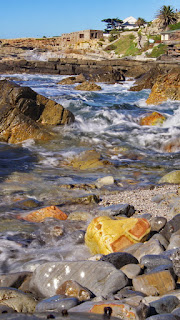Hey everybody!
So, I've been asked numerous times on how I get this effect. Well, I was inspired by a technique called the "Dragon Effect" as the linked video will show you. This, is my own variation of this "effect". It's still a bit of work, just like most of the youtube clips will explain to you.
Me, I think I've followed most of the steps, but, still doing it my way... I guess I have this thing about following rules... I use them as a guide.
Two more examples at the end of my story.
Your initial image should at least look good to start with. This example taken in the middle of the day is a good platform to work with, but not exactly the best.
Time to start putting this onion together, one layer at a time.
 |
| This guy was neglected by his decade long employers and left behind in a small town that is also neglected. |
Please note that I do all of this in the fantastic Photoshop CS5 and hope you will understand my tutorial here as I don't go into details. I don't show clips of settings, screen dumps or any of those that you see in other tutorials. I just tell you what I did and how I did it. I will however try to give you as much detail as I can remember.
(I'm glad I saved the .psd file so that I could dismantle it and give a brief on how-in-the-hell I did this.)
Right, first thing I did was to shift the shadow/highlights drastically.
(Image -> Asjustments -> Shadow/Highlights)
By shifting these sliders, you can tweak the levels until you find yorself with quite a nice balance between lifted shadows and darkened highlights.
Then a quick copy of the layer (Ctrl -J Win/Cmnd J Mac), which gets some Gaussian Blur thrown at it (Filter -> Blur -> Gaussian Blur). This is to wipe out any freaky looking ghosting and edge halo's that are caused by the shadow/highlight procedure. There are other ways, but this is what I did. Oh yes, don't forget to now ERASE the subject so that only the background is blurred (this can be achieved in various ways, such as using quick select too, magnetic lasso, or just erasing). I used a combo of quick select and eraser.
Ok, cool... So you've noticed a MAJOR saturation explosion, don't worry, we'll get to that. Before that (and this is why I'm not phased by the saturation) I add yet another layer. This layer gets desaturated (Ctrl+shift+U), then more shadow/highlights, then contrasted and finally, the layer filter is set to "Soft Light". Don't really notice it below? Probably because I shifted the fill and opacity just a tad...
Again, duplicated that same desaturated layer and gave it a hint of gaussian blur (less than half of the first blur used for the background) and the the fill and opacity brought back up to 100%.
Now, it's starting to look good and, as you'll notice, the saturation is slowly reducing...
Next steps are "the painter's steps" where I painstakingly sit with different size brushes of black and white and multiple layers (don't get intimidated, this is optional and can be done in different easy ways). Background get first priority... Remember your selection? It should still be available (Select -> reselect), if not, select again the same way you did for the blurred bachground. Cool?
Right, inverse this selection so that you now have the background selected and not your subject. Paint with brush, or use the paint bucket... either, or...
Oh, then set the layer to soft light. Background's looking cool, but still a bit of work.
Duplicate that layer, use a (reasonable sized) feathered eraser to trim around your subject so that you get a bit of a glow and nice rich, dark bacground, just like below.
This layer will get quite a heavy gaussian blur to blend it in nicely.
Okay, now the face, this is what can take the most time.
Another layer to the onion, set to soft light (again, sigh...) and this time, very small, feathered brushes will be used. Why? Because, stop asking questions.
This is to work on the details in the face, to accentuate the creases and "character lines" in his face, to make them stand out more.
There is another way, a photocopy layer, whites removed, blurred, but it isn't as effective as being selective and means a ton more erasing... I tried that route... it can be effective, but is just so time consuming.
Okay, the next two steps are basically, the same... okay, they are...
New layer, painted bucket black, erase the centre with large, very large feathered eraser with opacity set to around um, 20%. Then it's case if erasing from the centre outwards. Yeah, to create a vignette.
Duplicate that layer, erase a little more to have a lesser vignette. Play with these until desired effect.
Please note: They ARE optional, but work for me.
Okay... now it's time to deal with that saturation (which you could probably see, has been changing with each layer added) by using the new adjustment layer tool... selecting saturation and adjusting the master slider. You can, however also opt for selective colour saturation by clicking on the drop down box that says, Master... I just toned down the entire colour spectrum altogether.
Finally, I added my signature and then saved it.
(okay, I might have tweaked the brightness once more after)
That's it, as easy as that.
Do enjoy, let me know if there anything you'd like to know.
Okay, two more examples.
This one, I managed to get it better, practice...
the first one I did, this was done using the photocopy layer story I mentioned earlier.

















































